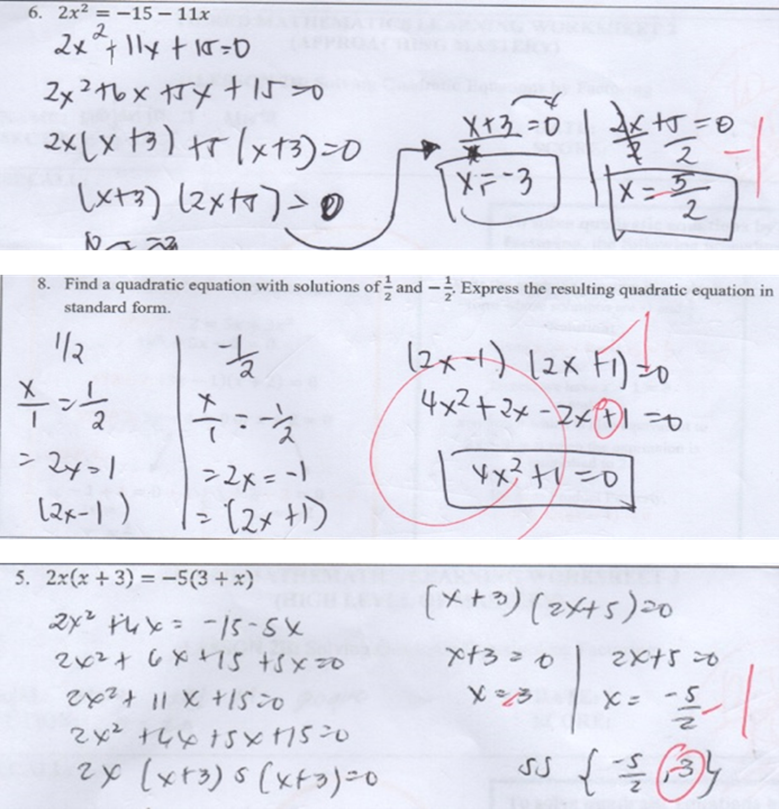Students’ common errors in quadratic equations: Towards improved mathematics performance
##plugins.themes.bootstrap3.article.main##
Abstract
With the aim to close the performance gap between the high performing and the low performing students, this descriptive qualitative study was conducted to analyze students’ common and persisting errors in quadratic equations. Forty-six (N=46) Grade 9 students in a public high school in the Philippines participated in the study. Homework was given where students received instructions from video recordings and other online learning materials using blended learning. The common errors students committed were not following directions, mishandling signs, difficulty in recognizing a quadratic equation, inability to distinguish between solving a quadratic equation and simplifying an algebraic expression, failure to express quadratic equations in standard form, disregarding the negative roots, computational errors in basic algebraic conventions in simplifying radical and rational expressions, factoring, performing special products, and in completing the square. Students were interviewed to validate the error analysis. Immediate feedback through a whole class discussion was conducted the following day to discuss the errors and mistakes committed by students in order to address these and help them learn the necessary concepts and skills in quadratic equations. Instructional strategies and interventions for teaching quadratic equations are recommended for future studies.
##plugins.themes.bootstrap3.article.details##

This work is licensed under a Creative Commons Attribution-ShareAlike 4.0 International License.
The author is responsible for acquiring the permission(s) to reproduce any copyrighted figures, tables, data, or text that are being used in the submitted paper. Authors should note that text quotations of more than 250 words from a published or copyrighted work will require grant of permission from the original publisher to reprint. The written permission letter(s) must be submitted together with the manuscript.References
Al Wahbi, A. (2014). The need for faculty training programs in effective feedback provision. Advances in Medical Education and Practice, 5, 263-268. https://doi.org/10.2147/AMEP.S62889
Bell, B. F. (1993). Children's science, constructivism and learning in science. Deakin University.
Buchheister, K., Jackson, C., & Taylor, C. E. (2017). Maths games: A universal design approach to mathematical reasoning. Australian Primary Mathematics Classroom, 22(4), 7-12.
Cox, L. S. (1975). Systematic errors in the four vertical algorithms in normal and handicapped populations. Journal for Research in Mathematics Education, 6(4), 202-220. https://doi.org/10.5951/jresematheduc.6.4.0202
Fitrianna, A. Y., & Rosjanuardi, R. (2021). Identification of junior high school students’ error types in understanding concept about relation and function. Infinity Journal, 10(2), 175-190. https://doi.org/10.22460/infinity.v10i2.p175-190
Gregory, G. H., & Chapman, C. (2013). Differentiated instructional strategies: One size doesn′t fit all. Corwin press.
Liew, C. Y., Leong, S. H., Julaihi, N. H., Lai, T. W., Ting, S. U., Chen, C. K., & Hamdan, A. (2022). Children’s errors in written mathematics. Mathematics Teaching-Research Journal, 14(5), 138-154.
Makonye, J., & Nhlanhla, S. (2014). Exploring ‘non-science’grade 11 learners’ errors in solving quadratic equations. Mediterranean journal of social sciences, 5(27), 634-644. https://doi.org/10.5901/mjss.2014.v5n27p634
Mendoza, M. J. L., & Lapinid, M. R. C. (2022). Online quizzes: The use of multiple attempts and feedback system. In Proceedings of the 2022 13th International Conference on E-Education, E-Business, E-Management, and E-Learning (pp. 124-131). https://doi.org/10.1145/3514262.3514271
Muis, K. R., Ranellucci, J., Trevors, G., & Duffy, M. C. (2015). The effects of technology-mediated immediate feedback on kindergarten students' attitudes, emotions, engagement and learning outcomes during literacy skills development. Learning and Instruction, 38, 1-13. https://doi.org/10.1016/j.learninstruc.2015.02.001
NCTM. (2014). Principles ro actions: Ensuring mathematical success for all. National Council of Teachers of Mathematics.
O’Connor, B. R., & Norton, S. (2022). Exploring the challenges of learning quadratic equations and reflecting upon curriculum structure and implementation. Mathematics Education Research Journal. https://doi.org/10.1007/s13394-022-00434-w
Peng, Y., Hong, E., & Mason, E. (2014). Motivational and cognitive test-taking strategies and their influence on test performance in mathematics. Educational Research and Evaluation, 20(5), 366-385. https://doi.org/10.1080/13803611.2014.966115
Rattadilok, P., & Roadknight, C. (2018). Improving student's engagement through the use of learning modules, instantaneous feedback and automated marking. In 2018 IEEE International Conference on Teaching, Assessment, and Learning for Engineering (TALE) (pp. 802-806). https://doi.org/10.1109/TALE.2018.8615306
Smith, S. J., & Harvey, E. E. (2014). K-12 online lesson alignment to the principles of universal design for learning: the Khan Academy. Open Learning: The Journal of Open, Distance and e-Learning, 29(3), 222-242. https://doi.org/10.1080/02680513.2014.992402
Sumarno, S., Setyosarİ, P., & Haryono, H. (2017). Effect of feedback strategy and motivation of achievement to improving learning results concept in learning civic education in vocational high school. European Journal of Educational Research, 6(4), 441-453. https://doi.org/10.12973/eu-jer.6.4.441
Tendere, J., & Mutambara, L. H. N. (2020). An analysis of errors and misconceptions in the study of quadratic equations. European Journal of Mathematics and Science Education, 1(2), 81-90. https://doi.org/10.12973/ejmse.1.2.81
Thomas, D. S., & Mahmud, M. S. (2021). Analysis of students’ error in solving quadratic equations using Newman’s procedure. International Journal of Academic Research in Business and Social Sciences, 11(12), 222-237. https://doi.org/10.6007/IJARBSS/v11-i12/11760
Tomlinson, C. (2005). This issue: Differentiated instruction. Theory Into Practice, 44(3), 183-184. https://doi.org/10.1207/s15430421tip4403_1
Zakaria, E., Ibrahim, I., & Maat, S. M. (2010). Analysis of students' error in learning of quadratic equations. International Education Studies, 3(3), 105-110.

